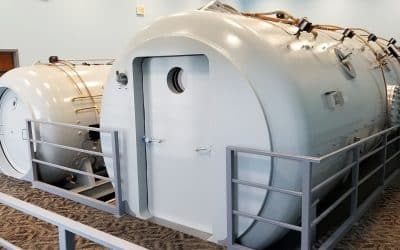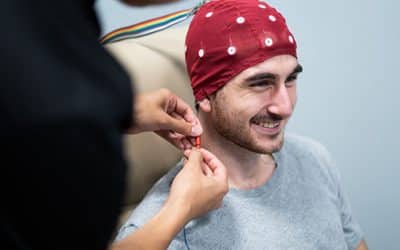Hyperbaric oxygen therapy (HBOT) can help heal bowel fistulas in patients with advanced Crohn's disease, according to a systematic review and meta-analysis. Overall, use of HBOT was associated with a 87% clinical response rate...
Key Crohn’s Disease Research
Explore our database on Key Crohn’s Disease Research and Hyperbaric Oxygen Therapy aka, HBOT, below. Extivita maintains an extensive research & publication database for various diseases and therapies such as Hyperbaric Oxygen Therapy, Neurofeedback, Nutritional IV Therapy, Infrared Sauna, and Pulsed Electromagnetic Field Therapy.
For a complete list of indications treated at Extivita, explore the conditions we treat.
Cognitive impairment in Crohn’s disease is associated with systemic inflammation, symptom burden and sleep disturbance
Abstract Background: Patients with Crohn's disease (CD) frequently complain of cognitive difficulties such as problems with concentration and clouding of thought, yet this has scarcely been objectively defined and underlying mechanisms remain unknown. Objective: The...
Hyperbaric oxygen therapy for chronic antibiotic-refractory ischemic pouchitis.
Hyperbaric oxygen therapy (HBOT) has been shown to be efficacious in treating various conditions, including perianal Crohn’s disease. Here we present a case of a 59-year-old male with a history of ulcerative colitis, who underwent a total proctocolectomy and two-stage J-pouch construction. He later developed chronic antibiotic-refractory pouchitis with endoscopic features of ischemia. At the completion of HOBT-a total of 20 sessions of 100% oxygen at 2.5-3.0 atmospheres absolute for 60-90 minutes per session-a repeat pouchoscopy showed marked improvement of endoscopic mucosal inflammation. HBOT is known to increase tissue oxygenation, reduce tissue hypoxia, alter inflammatory pathways and promote tissue healing.
Enhanced colonic nitric oxide generation and nitric oxide synthase activity in ulcerative colitis and Crohn’s disease
Recent studies have suggested that nitric oxide (NO.), the product of nitric oxide synthase in inflammatory cells, may play a part in tissue injury and inflammation through its oxidative metabolism. In this study the colonic generation of oxides of nitrogen (NOx) and nitric oxide synthase activity was determined in ulcerative colitis and Crohn’s disease. Colonic biopsy specimens were obtained from inflammatory bowel disease patients and from normal controls. Mucosal explants were cultured in vitro for 24 hours and NOx generation was determined. Nitric oxide synthase activity was monitored by the conversion of [3H]-L-arginine to citrulline. Median NOx generation by inflamed colonic mucosa of patients with active ulcerative colitis and Crohn’s colitis was 4.2- and 8.1-fold respectively higher than that by normal human colonic mucosa. In ulcerative colitis and Crohn’s colitis nitric oxide synthase activity was 10.0- and 3.8-fold respectively higher than in normal subjects.
Role of immunosuppressives in special situations: perianal disease and postoperative period.
Complex perianal disease is associated with poor outcome and requires early effective therapy. Corticosteroids are not effective in perianal fistulising Crohn’s disease, and antibiotics, immunosuppressants and anti-TNF therapy are required. It is important to consider combined medical surgical therapy after accurate imaging using an MRI scan of the pelvis. Drainage of any abscess at examination under anaesthesia and seton insertion are important before introduction of immunosuppressants and anti-TNF therapy. Long-term follow up of patients in a single centre reported responders to azathioprine having a reduced risk of perianal surgery (OR = 0.36; 95% CI: 0.27-0.46), but complex perianal fistulising Crohn’s disease generally requires combination therapy with anti-TNF and azathioprine.
Efficacy of hyperbaric oxygen in patients with Crohn’s disease: two case reports.
Crohn’s disease is an inflammatory disease of the gastrointestinal tract, usually involving the ileum, that can lead to debilitating symptoms of abdominal pain, diarrhea and malabsorption during acute exacerbations. Because there is no known cause of the illness, treatment is based upon symptomatology and may ultimately require bowel resection if response to medical therapy is inadequate. Treatment with hyperbaric oxygen has shown promise in the reduction of inflammation associated with acute exacerbations of Crohn’s disease, with alleviation of symptoms and an improvement in quality of life. We present two cases of pediatric patients with exacerbations of Crohn’s disease who underwent cycles of hyperbaric oxygen therapy.
[Hyperbaric oxygen in the treatment of perineal Crohn’s disease era of infliximab: a renewal interest?].
Despite the growing number of therapeutic methods and the recent introduction of new drugs more active in the therapeutic arsenal, lesions of the ano-perineal Crohn’s disease remains difficult to support. Hyperbaric oxygen (HBO) was made before the era of infliximab, an interesting therapeutic approach in which the current position remains unclear. To assess HBO efficacy in the treatment of anal fistulas refractory Crohn’s disease. Literature review. Hyperbaric oxygen therapy was used in the 90’s when the biotherapy was not part of the armamentarium for Crohn’s disease. Research conducted has identified only nine publications evaluating the efficacy of hyperbaric oxygen therapy in the treatment of anal fistulas refractory Crohn’s disease.
HBOT for inflammatory bowel disease
Traditionally, hyperbaric oxygen treatment (HBOT) has been used to treat a limited repertoire of disease, including decompression sickness and healing of problem wounds. However, some investigators have used HBOT to treat inflammatory bowel disease (IBD), including Crohn’s disease and ulcerative colitis.
Comprehensive searches were conducted in 8 scientific databases through 2011 to identify publications using HBOT in IBD. Human studies and animal models were collated separately.
Is alpha wave neurofeedback effective with randomized clinical trials in depression? A pilot study
Abstract Frontal asymmetric activation has been proposed to be the underlying mechanism for depression. Some case studies have reported that the enhancement of a relative right frontal alpha activity by an asymmetry neurofeedback training leads to improvement in...





